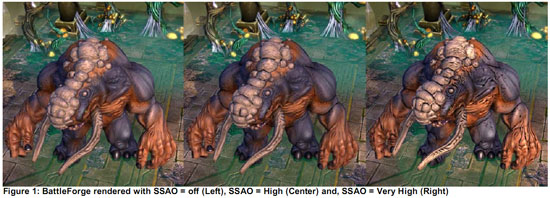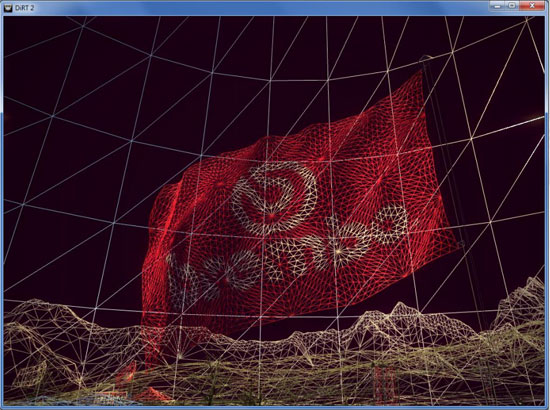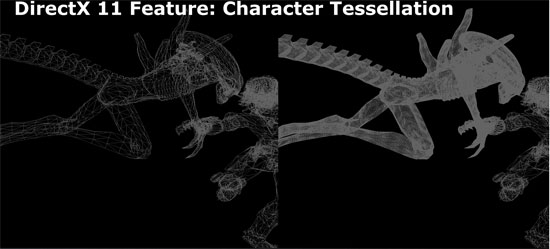AMD's Radeon HD 5870: Bringing About the Next Generation Of GPUs
by Ryan Smith on September 23, 2009 9:00 AM EST- Posted in
- GPUs
The First DirectX 11 Games
With any launch of a new DirectX generation of hardware, software availability becomes a concern. As the hardware needs to come before the software so that developers can tailor their games’ performance, it’s just not possible to immediately launch with games ready to go. For the launch of DirectX 11 and the 5800 series, AMD gave us a list of what games to expect and when.
First out of the gate is Battleforge, EA’s card-based online-only RTS. We had initially been told that it would miss the 5870 launch, but in fact EA and AMD managed to get it in under the wire and deliver it a day early. This gives AMD the legitimate claim of having a DX11 title out there that only their new hardware can fully exploit, and from a press perspective it’s nice to have something out there we can test besides tech demos. Unfortunately we wrapped up our testing 2 days early in order to attend IDF, which means we have not yet had a chance to benchmark this title’s DX11 mode or look at it in-depth.
We did have a chance to see the title in action quickly at AMD’s press event 2 weeks ago, where AMD was using it to show off High Definition Ambient Occlusion. As far as we can tell, HDAO is the only DX11 wonder-feature that it current implements, which makes sense given that it should be the easiest to patch in.

The next big title in AMD’s stack of DX11 games is STALKER: Call of Pripyat. This game went gold in Russia earlier this week, with the English version some time behind it. Unfortunately we don’t know what DX11 features it will be using, but as STALKER games have historically been hard on computers, it should prove to be an interesting test case for DX11 performance.
DIRT 2 is a title that got a great deal of promotion at AMD’s press event. AMD has been using it to show off their 6-way Eyefinity configuration, and we had a chance to play it quickly in their testing labs when looking at Eyefinity. This should be a fuller-featured DX11 game, utilizing tessellation, better shadow filtering, and other DX11 features. Certainly it’s the closest thing AMD’s going to have for a showcase title this year for the DX11 features of their hardware, and the console version has been scoring well in reviews. The PC version is due December 11th.

Finally, AMD had Rebellion Games in house to show off an early version of Aliens vs. Predator. This was certainly the most impressive title shown, with Rebellion showing off tessellation and HDAO in real time. Unfortunately screenshots don’t really do the game justice here; the difference from using DX11 is far more noticeable in motion. At any rate, this game is the farthest out – it won’t ship until Q1 of next year at the earliest.











327 Comments
View All Comments
mapesdhs - Saturday, September 26, 2009 - link
MODel3 writes:
> 1.Geometry/vertex performance issues ...
> 2.Geometry/vertex shading performance issues ...
Would perhaps some of the subtests in 3DMark06 be able to test this?
(not sure about Vantage, never used that yet) Though given what Jarred
said about the bandwidth and other differences, I suppose it's possible
to observe large differences in synthetic tests which are not the real
cause of a performance disparity.
The trouble with heavy GE tests is, they often end up loading the fill
rates anyway. I've run into this problem with the SGI tests I've done
over the years:
http://www.sgidepot.co.uk/sgi.html">http://www.sgidepot.co.uk/sgi.html
The larger landscape models used in the Inventor tests are a good
example. The points models worked better in this regard for testing
GE speed (stars3/star4), but I don't know to what extent modern PC
gfx is designed to handle points modelling - probably works better
on pro cards. Actually, Inventor wasn't a good choice anyway as it's
badly CPU-bound and API-heavy (I should have used Performer, gives
results 5 to 10X faster).
Anyway, point is, synthetic tests might allow one to infer that one
aspect of the gfx pipeline is a bottleneck when infact it isn't.
Ages ago I emailed NVIDIA (Ujesh, who I used to know many moons ago,
but alas he didn't reply) asking when, if ever, they would add
performance counters and other feedback monitors to their gfx
products so that applications could tell what was going on in the
gfx pipeline. SGI did this ages years ago, which allowed systems like
IR to support impressive functions such as Dynamic Video Resizing by
being able to monitor frame by frame what was going on within the gfx
engine at each stage. Try loading any 3D model into perfly, press F1
and click on 'Gfx' in the panel (Linux systems can run Performer), eg.:
http://www.sgidepot.co.uk/misc/perfly.gif">http://www.sgidepot.co.uk/misc/perfly.gif
Given how complex modern PC gfx has become, it's always been a
mystery to me why such functions haven't been included long ago.
Indeed, for all that Crysis looks amazing, I was never that keen on
it being used as a benchmark since there was no way of knowing
whether the performance hammering it created was due to a genuinely
complex environment or just an inefficient gfx engine. There's still
no way to be sure.
If we knew what was happening inside the gfx system, we could easily
work out why performance differences for different apps/games crop
up the way they do. And I would have thought that feedback monitors
within the gfx pipe would be even more useful to those using
professional applications, just as it was for coders working on SGI
hardware in years past.
Come to think of it, how do NVIDIA/ATI even design these things
without being able to monitor what's going on? Jarred, have you ever
asked either company about this?
Ian.
JarredWalton - Saturday, September 26, 2009 - link
I haven't personally, since I'm not really the GPU reviewer here. I'd assume most of their design comes from modeling what's happening, and with knowledge of their architecture they probably have utilities that help them debug stuff and figure out where stalls and bottlenecks are occurring. Or maybe they don't? I figure we don't really have this sort of detail for CPUs either, because we have tools that know the pipeline and architecture and they can model how the software performs without any hardware feedback.MODEL3 - Thursday, October 1, 2009 - link
I checked the web for synthetic geometry tests.Sadly i only found 3dMark Vantage tests.
You can't tell much from them, but they are indicative.
Check:
http://www.pcper.com/article.php?aid=783&type=...">http://www.pcper.com/article.php?aid=783&type=...
GPU Cloth: 5870 is only 1,2X faster than 4890. (vertex/geometry shading test)
GPU Particles: 5870 is only 1,2X faster than 4890. (vertex/geometry shading test)
Perlin Noise: 5870 is 2,5X faster than 4890. (Math-heavy Pixel Shader test)
Parallax Occlusion Mapping: 5870 is 2,1X faster than 4890. (Complex Pixel Shader test)
All the above 4 tests are not bandwidth limited at all.
Just for example, if you check:
http://www.pcper.com/article.php?aid=674&type=...">http://www.pcper.com/article.php?aid=674&type=...
You will see that a 750MHz 4870 512MB is 20-23% faster than a 625MHz 4850 in all the above 4 tests, so the extra bandwidth (115,2GB/s vs 64GB/s) it doesn't help at all.
But 4850 is extremely bandwidth limited in the color fillrate test (4870 is 60% faster than 4850)
Also it shouldn't be a problem of the dual rasterizer/dual SIMDs engine efficiency since synthetic Pixel Shader tests is fine (more than 2X) while the synthetic geometry shading tests is only 1,2X.
My guess is ATI didn't improve the classic geometry set-up engine and the GS because they want to promote vertex/geometry techniques based on the DX11 tesselator from now on.
Zool - Friday, September 25, 2009 - link
In Dx11 the fixed tesselation units will do much finer geometry details for much less memmory space and on chip so i think there isnt a single problem with that. Also the compute shader need minimal memory bandwith and can utilize plenty of idle shaders. The card is designed with dx11 in mind and it isnt using the wholle pipeline after all. I wouldnt make too early conclusions.(I think the perfomance will be much better after few drivers)MODEL3 - Saturday, September 26, 2009 - link
The DX11 tesselator in order to be utilized must the game engine to take advantage of it.I am not talking about the tesselator.
I am talking about the classic Geometry unit (DX9/DX10 engines) and the Geometry Shader [GS] (DX10 engines only).
I'll check to see if i can find a tech site that has synthetic bench for Geometry related perf. and i will post again tomorrow, if i can find anything.
JarredWalton - Friday, September 25, 2009 - link
It's worth noting that when you factor in clock speeds, compared to the 5870 the 4870X2 offers 88% of the core performance and 50% more bandwidth. Some algorithms/games require more bandwidth and others need more core performance, but it's usually a combination of the two. The X2 also has CrossFire inefficiencies to deal with.More interesting perhaps is that the GTX 295 offers (by my estimates, which admittedly are off in some areas) roughly 10% more GPU shader performance, about 18.5% more fill rate, and 46% more bandwidth than the HD 5870. The fact that the HD 4870 is still competitive is a good sign that ATI is getting good use of their 5 SPs per Stream Processor design, and that they are not memory bandwidth limited -- at least not entirely.
SiliconDoc - Wednesday, September 30, 2009 - link
The 4870x2 has somewhere around "double the data paths" in and out of it's 2 cpu's. So what you have with the 5870 putting as some have characterized " 2x 770 cores melded into one " is DOUBLE THE BOTTLENECK in and out of the core.They tried to compensate with ddr5 1200/4800 - but the fact remains, they only get so much with that "NOT ENOUGH DATA PATHS/PINS in and out of that gpu core."
cactusdog - Friday, September 25, 2009 - link
Omg these cards look great. Lol Silicon Doc is so gutted and furious he is making hmself look like a dam fool again only this time he should be on suicide watch...Nvidia cards are now obsolete..LOL.mapesdhs - Friday, September 25, 2009 - link
Hehe, indeed. Have you ever seen a scifi series called, "They Came
From Somewhere Else?" S.D.'s getting so worked up, reminds me of
the scene where the guy's head explodes. :D
Hmm, that's an alternative approach I suppose in place of post
moderation. Just get someone so worked up about something they'll
have an aneurism and pop their clogs... in which case, I'll hand
it back to Jarred. *grin*
Ian.
SiliconDoc - Friday, September 25, 2009 - link
That is quite all right, you fellas make sure to read it all, I am more than happy that the truth is sinking into your gourds, you won't be able to shake it.I am very happy about it.